Lead
Lead has enabled some of the most significant leaps forward in technology and civilisation over the last 7,000 years. Today it’s one of the most-used metals worldwide, in everything from battery storage to healthcare applications, and cable sheathing to sound insulation.
Lead was the first metal mined in Australia, in 1841 at Glen Osmond. Over the next century, a handful of lead ore deposits laid the foundation for today’s thriving mining industry. Today, Australia is the world’s largest lead producer and exporter, with 12.3 million tonnes in proved and probable reserves.
At Boab Metals Ltd (ASX: BML) we are adding our name to the list of lead miners who shaped the country, developing the Sorby Hills lead-silver deposit. We’re doing it safely and in partnership with our community.
Powerhouse future: Lead miners on the ASX
Lead (Pb) has been used in uncountable ways since at least 5,000 BC. Modern innovations in safety and technology have enabled lead to become one of the crucial materials for Australia’s green energy revolution. It is almost 100% recyclable, with more than 60% of new production originating in end-of-life products.
The last 20 years have seen ASX-listed lead miners make significant environmental management, safety, transport and efficiency advancements. As we look to a future where lead is used in the batteries that reduce our reliance on coal-fired power, these steps towards sustainability are crucial.
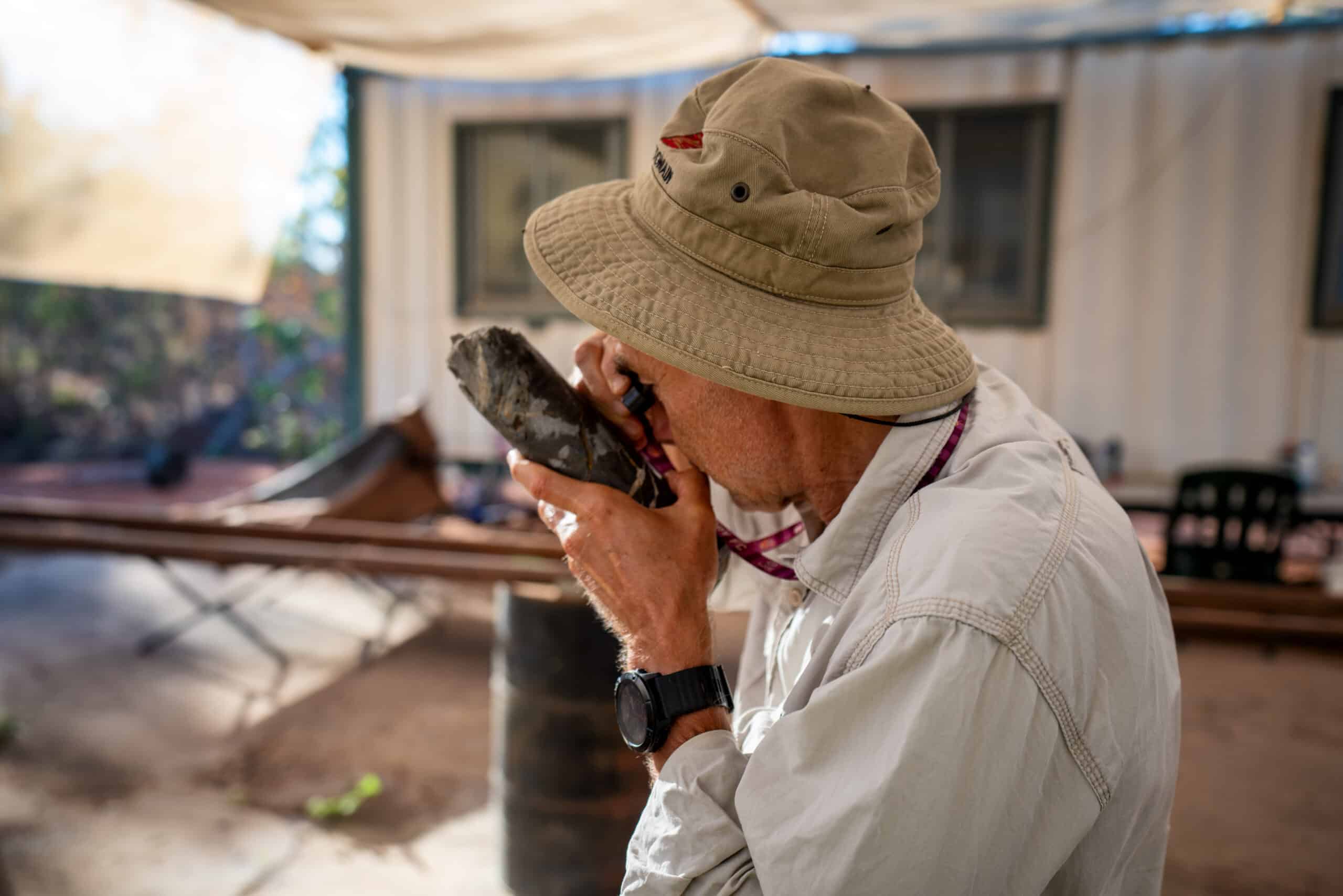

What is lead
used for?
In terms of applications, lead ranks after aluminium, copper and zinc. It’s
easy to overlook lead’s importance. But look a little closer, and you’ll notice
that lead is not only one of the most in–demand battery minerals; it’s also
used in healthcare, communications and manufacturing.
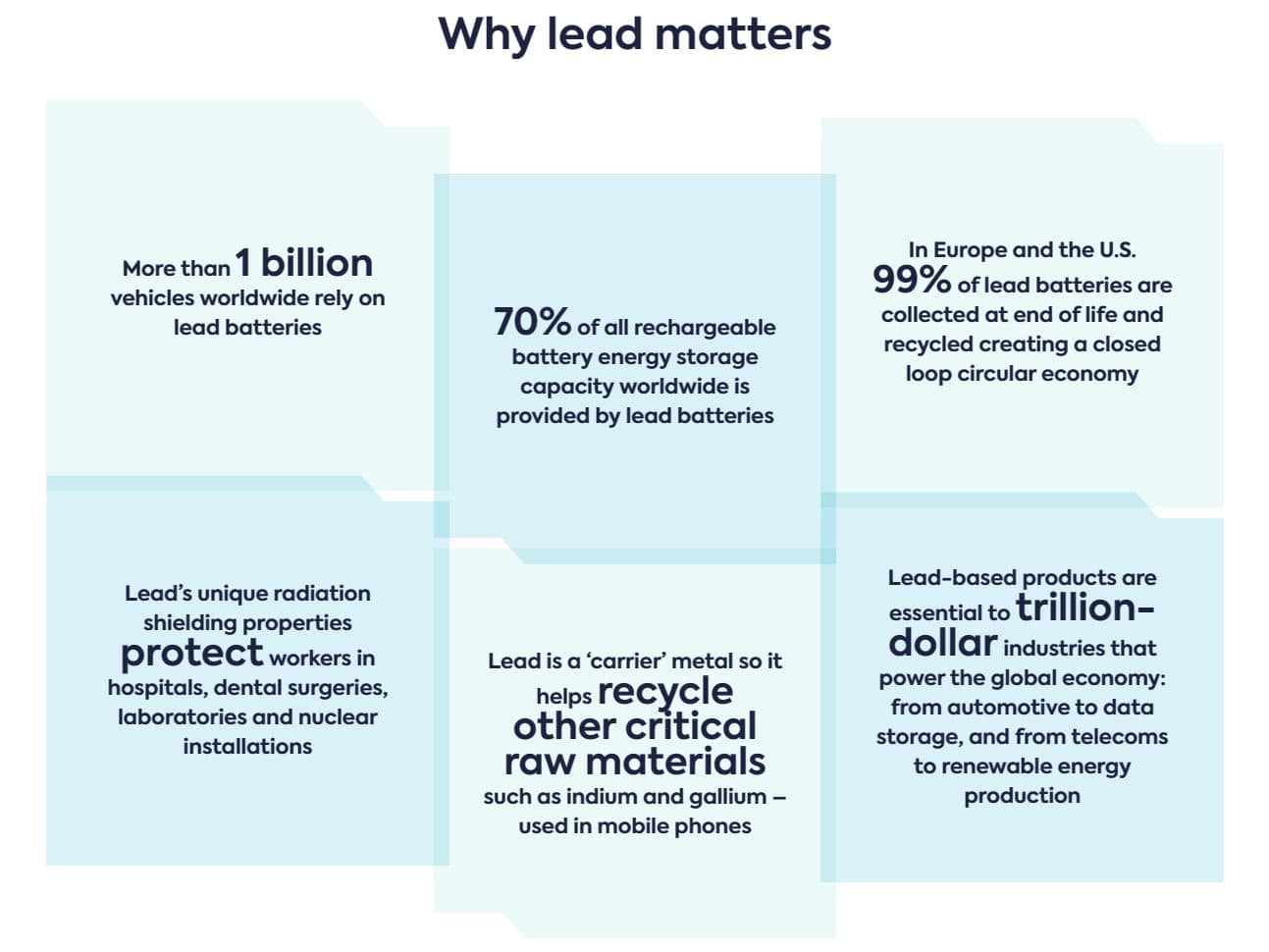

Lead-acid batteries
Thanks to its high electrical conductivity and resistance to corrosion, lead is primarily used in battery storage. Electric vehicles (EVs) and hybrids, backup generators for hospitals and communication systems, solar farms, and wind turbines; these are just some of the places you can find lead-acid batteries backing up vital power networks.
Healthcare
Lead’s high density makes it an excellent radiation shield. Lightweight lead aprons protect healthcare workers, while operating X-ray and nuclear equipment containing potentially harmful radiation. Lead is the preferred material used in radiation shielding.
Sound insulation
The same density and highly absorbent qualities make lead an excellent insulator for sound and vibration. Thin lead lamination on aluminium, steel or plywood provides highly effective sound installation, and lead footings significantly improve vibration absorption. Cable sheathing Lead’s ductility and corrosion resistance are ideal for cable sheathing. Undersea cables – including the one carrying the internet – are sheathed in lead.
Weights
From SCUBA diving to boat keels to weighted curtains, lead is used as a weight and balance for a wide range of applications. With a relatively high density of 11.29 g/m3, it only takes a little lead to get the job done.
Lead ASX
Investing in lead takes many forms today. There are strategies for institutional and individual investors, from investing in lead miners on the ASX to ETFs that include lead and battery minerals. Technological innovations are expected to drive demand for lead in the coming years. Beyond battery storage, lead helps to reclaim other metals in the recycling process, and its applications in construction.
Boab Metals Ltd: Delivering metals for a sustainable future
Sorby Hills is Australia’s largest undeveloped lead-silver deposit, with over 500,000 tonnes of payable lead. As we near production, the Sorby Hills Project could become a major player on the ASX and in international battery minerals markets. Boab Metals Ltd is well positioned to supply high-quality lead ore that will be used in lead-acid EV batteries, or refined into healthcare equipment, communications equipment and a plethora of industrial applications.
Lead Supply & Demand
The Sorby Hills Project is set to deliver metals for a sustainable future with highly recyclable lead metal for use largely in automotive applications including and increasingly in electric vehicles
Lead Supply
The production and consumption of lead-silver flotation concentrate is a mature market with lead mines and concentrators, producing concentrates that are sold to smelters throughout the world to produce refined lead metal and refined silver metal. A peculiarity of the global lead market is the large contribution of recycled lead (or secondary lead) to the overall supply making lead the most highly recycled of all the metals. In 2021, global lead production from mines was 4.5 Mt while refined lead production was 13.2 Mt making for 8.7 Mt of secondary lead supply into the market or 66%. In 2022 the proportion of refined lead sourced from recycled lead is forecast to be steady year on year at 66.5%. A plot of primary and secondary lead production is contained in the figure
Primary and Secondary Lead Production History/Forecast
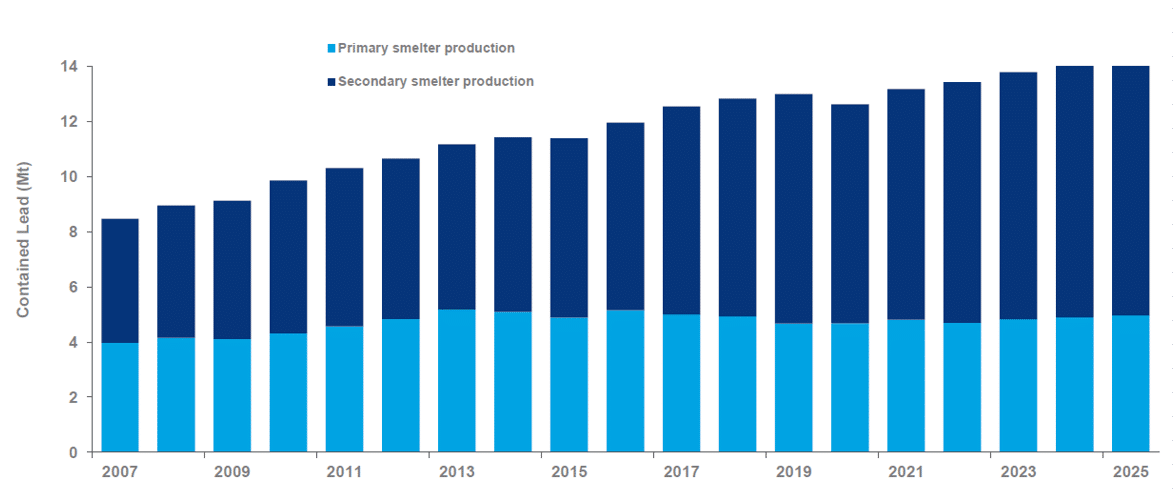
Source: Wood Mackenzie LME Forum 2022 Presentation October 2022
Lead supply from mine production is dominated by China which generated 44% of the 2021 global output with the next highest suppliers being Australia/Oceania and North America with 12% each. A plot of global lead mine production history/forecast by region is contained in the figure below.
Global Lead Mine Production History/Forecast

Source: Wood Mackenzie Global lead short-term outlook October 2022 (excel)
A modest increase in lead mine production is forecast from 2022 to 2032, only increasing by an average 0.5% per annum from 4.5Mt in 2022 to 4.8Mt in 2032. This is despite allowing for production from new projects and allowances for disruptions to planned production. Overall, current mine production capability is expected to fall from 2024. See the figure below.
Global Lead Mine Production Capacity History/Forecast by Country/Region
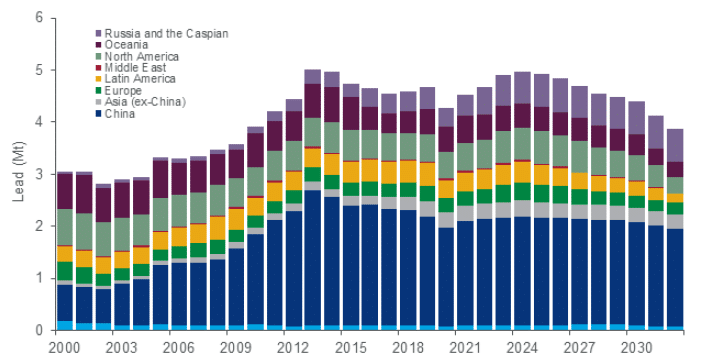
Source: Wood Mackenzie Global Lead Investment Horizon Outlook Q3 2022 – September 2022
Lead Demand
The major end use for lead is for lead-acid batteries for automotive applications with 70% of all rechargeable battery energy storage capacity worldwide provided by lead batteries. Lead-acid Batteries are a mature and commoditised technology making them a cheap and reliable source of 12V power for SLI, Stop-Start, safety and auxiliary functions in all types of vehicles. In 2021, 87% of lead demand was from automotive and industrial batteries as contained in the figure below.
Lead Consumption Breakdown by Use 2021
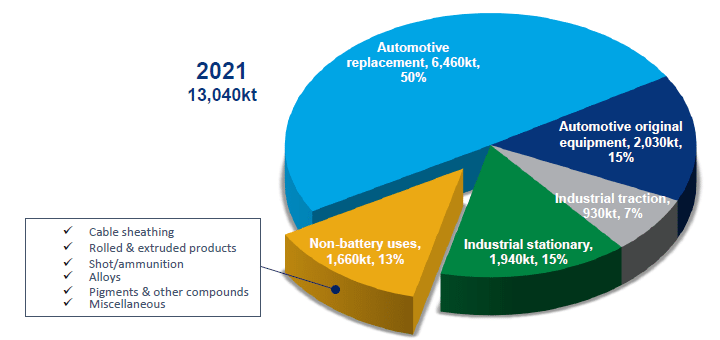
Source: Wood Mackenzie Lead Outlook Presentation Q4 2021
Lead demand is forecast to increase into the future at a CAGR of 1.4% from 2022 to 2032 largely driven by increased consumption in China and India (See figure below)
Global Lead Demand by Country/Region
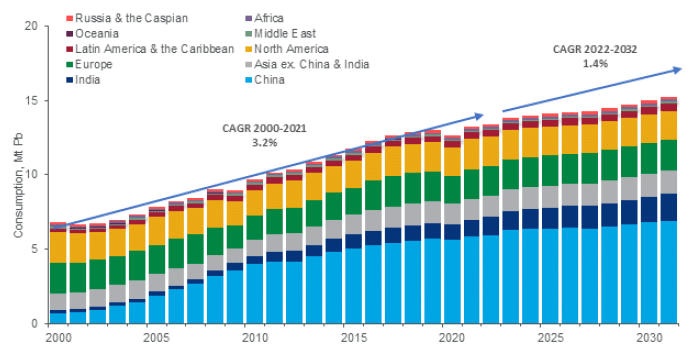
Source: Wood Mackenzie Global Lead Investment Horizon Outlook Q3 2022 – September 2022
Despite an overall gradual decrease in demand for lead in internal combustion engine applications, the forecast increase in demand for Hybrid EV, Plug-in EV and Battery EV results is an overall lead demand increase (See figure below).
Automotive Lead Demand by Type

Source: Wood Mackenzie LME Forum 2022 Presentation October 2022










